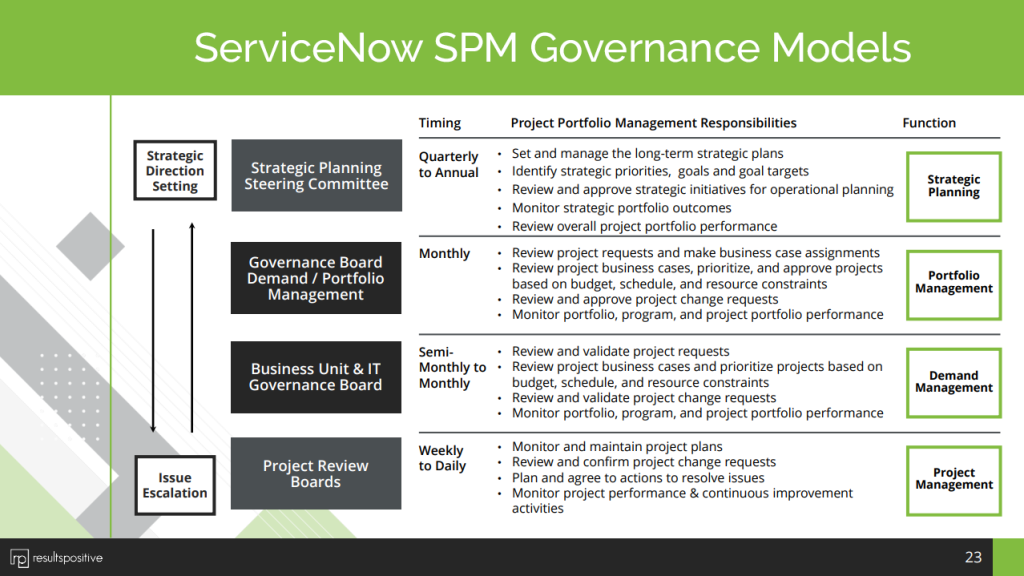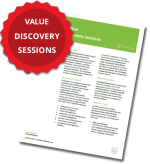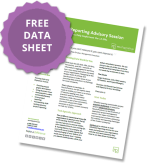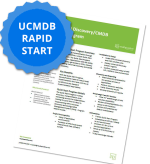Navigating ServiceNow SPM Governance Best Practices
In today’s fast-paced business landscape, aligning projects with strategic objectives is a top priority for IT managers, project leaders, and business unit heads. ServiceNow Strategic Portfolio Management (SPM) offers a powerful platform to streamline portfolio and project management, but its success hinges on a well-defined governance structure. Governance ensures that decisions are made efficiently, resources are allocated wisely, and risks are managed proactively.
This blog post dives into ServiceNow SPM Governance Best Practices, exploring a structured model with four key levels: the Strategic Planning Steering Committee, Governance Board/Demand & Portfolio Management, Business Unit & IT Governance Board, and Project Review Boards. Each level operates on a specific timeline and carries distinct responsibilities, creating a cohesive framework that balances strategic vision with operational execution. Read on to discover actionable best practices tailored to enhance your governance processes.
Introduction to ServiceNow SPM Governance
ServiceNow SPM empowers organizations to manage portfolios, prioritize projects, and align resources with long-term goals. However, without a clear governance framework, even the most advanced tools can fall short. Governance provides the structure for accountability, decision-making, and oversight, ensuring that every project contributes to organizational success.
The governance model outlined here includes four levels, each with a unique cadence and focus:
-
Strategic Planning Steering Committee: Meets quarterly to annually, setting the strategic direction.
-
Governance Board/Demand & Portfolio Management: Meets monthly, overseeing portfolio health and project prioritization.
-
Business Unit & IT Governance Board: Meets semi-monthly to monthly, aligning projects with business needs.
-
Project Review Boards: Meets weekly to daily, driving project execution.
This hierarchy ensures that strategic priorities flow downward while issues escalate upward, fostering alignment and responsiveness. Let’s explore each level and the best practices that make them effective.
Strategic Planning Steering Committee: Setting the Vision
Timing: Quarterly to Annual
The Strategic Planning Steering Committee operates at the top of the governance model, meeting quarterly to annually. Its role is to define the organization’s long-term strategic plans, identify priorities, approve initiatives, and monitor portfolio outcomes.
Responsibilities
-
Establish long-term strategic plans and goals.
-
Identify key priorities and targets.
-
Approve strategic initiatives for execution.
-
Monitor portfolio performance and outcomes.
Best Practices
-
Clarify Strategic Objectives: Define goals that are specific and actionable, ensuring all portfolio activities align with the broader vision. This clarity guides decision-making at every level.
-
Involve Diverse Stakeholders: Include leaders from IT, business units, and other key areas in planning sessions. Their input ensures a comprehensive strategy that reflects organizational needs.
-
Review and Adjust Regularly: Use performance insights to assess the effectiveness of strategic initiatives. Periodic reviews allow the committee to adapt plans to changing priorities.
By setting a strong foundation, this committee ensures that all governance activities support the organization’s overarching mission.
Governance Board/Demand & Portfolio Management: Prioritizing for Impact
Timing: Monthly
The Governance Board meets monthly to review project requests, prioritize initiatives, and monitor portfolio performance. This level bridges strategic planning with operational execution, ensuring that projects align with goals while respecting resource constraints.
Responsibilities
-
Review and assign business cases for project requests.
-
Prioritize and approve projects based on budget, schedule, and resources.
-
Approve project change requests.
-
Monitor overall portfolio performance.
Best Practices
-
Implement a Structured Evaluation Process: Develop clear criteria—such as strategic alignment and resource availability—for approving projects. This consistency enhances decision quality.
-
Stay Agile with Portfolio Adjustments: Regularly assess portfolio health to shift resources or priorities as new needs emerge. Flexibility keeps the portfolio relevant and impactful.
-
Encourage Cross-Departmental Collaboration: Bring together representatives from various functions to review requests. Diverse perspectives improve prioritization and reduce silos.
A disciplined yet adaptable approach at this level ensures that the portfolio delivers maximum value.
Business Unit & IT Governance Board: Aligning with Business Needs
Timing: Semi-Monthly to Monthly
The Business Unit & IT Governance Board meets semi-monthly to monthly, focusing on validating project requests and ensuring alignment with business unit objectives. This board fosters collaboration between IT and business teams, balancing technical feasibility with operational demands.
Responsibilities
-
Validate project requests and business cases.
-
Prioritize projects based on budget, schedule, and resources.
-
Review and approve change requests.
-
Monitor portfolio and project performance.
Best Practices
-
Thoroughly Vet Requests: Scrutinize each project’s purpose, scope, and resource needs to ensure it supports business goals. This prevents resource waste on misaligned initiatives.
-
Strengthen IT-Business Partnerships: Promote open dialogue between IT and business units to align technical solutions with operational priorities. Collaboration drives better outcomes.
-
Proactively Track Progress: Regularly review performance and change requests to catch issues early. This keeps projects on course and maintains portfolio integrity.
By bridging IT and business perspectives, this board ensures that projects deliver measurable value.
Project Review Boards: Driving Execution and Accountability
Timing: Weekly to Daily
Project Review Boards operate at the ground level, meeting weekly to daily to oversee project execution. Their frequent cadence allows for real-time monitoring, issue resolution, and performance tracking.
Responsibilities
-
Maintain and monitor project plans.
-
Review and confirm change requests.
-
Resolve issues and agree on action plans.
-
Track project performance and improvement efforts.
Best Practices
-
Keep Plans Current and Detailed: Ensure project plans clearly outline tasks, timelines, and responsibilities. Up-to-date plans minimize confusion and keep teams aligned.
-
Enable Rapid Decision-Making: Empower project managers to approve changes and address issues quickly. A streamlined process prevents delays and maintains momentum.
-
Focus on Continuous Improvement: Use performance insights to refine processes and apply lessons learned. This builds a culture of accountability and excellence.
Frequent oversight and decisive action at this level keep projects on track and aligned with strategic goals.
Strategic Direction and Issue Escalation: Ensuring Alignment
A hallmark of this governance model is its dual flow: strategic direction cascades from the Strategic Planning Steering Committee down to Project Review Boards, while issues escalate upward as needed. This dynamic ensures that every level works toward the same objectives and responds promptly to challenges.
Best Practices
-
Establish Clear Escalation Channels: Define when and how issues should move up the hierarchy. This clarity speeds up resolution and avoids bottlenecks.
-
Act Swiftly on Escalated Issues: Encourage Project Review Boards to escalate problems promptly and higher levels to address them decisively. Timely action preserves project momentum.
-
Learn from Escalations: Document issues and resolutions to refine processes over time. This builds resilience and improves future governance efforts.
This interconnected flow keeps the organization aligned, responsive, and focused on success.
Elevating Your Governance Game
Effective ServiceNow SPM Governance Best Practices hinge on a structured model that integrates strategic oversight with operational agility. The Strategic Planning Steering Committee sets the vision with quarterly to annual reviews, the Governance Board prioritizes monthly, the Business Unit & IT Governance Board aligns semi-monthly to monthly, and Project Review Boards drive execution weekly to daily. Together, these levels create a robust framework for decision-making and accountability.
To succeed, focus on:
-
Setting clear, stakeholder-driven strategic goals.
-
Prioritizing projects with a structured, flexible process.
-
Bridging IT and business needs through collaboration.
-
Empowering teams to execute and resolve issues quickly.
-
Maintaining alignment through strategic direction and escalation.
Assess your current governance practices today and consider adopting these best practices. By optimizing your ServiceNow SPM governance, you’ll enhance decision-making, resource efficiency, and project outcomes—unlocking the full potential of your portfolio management efforts.











